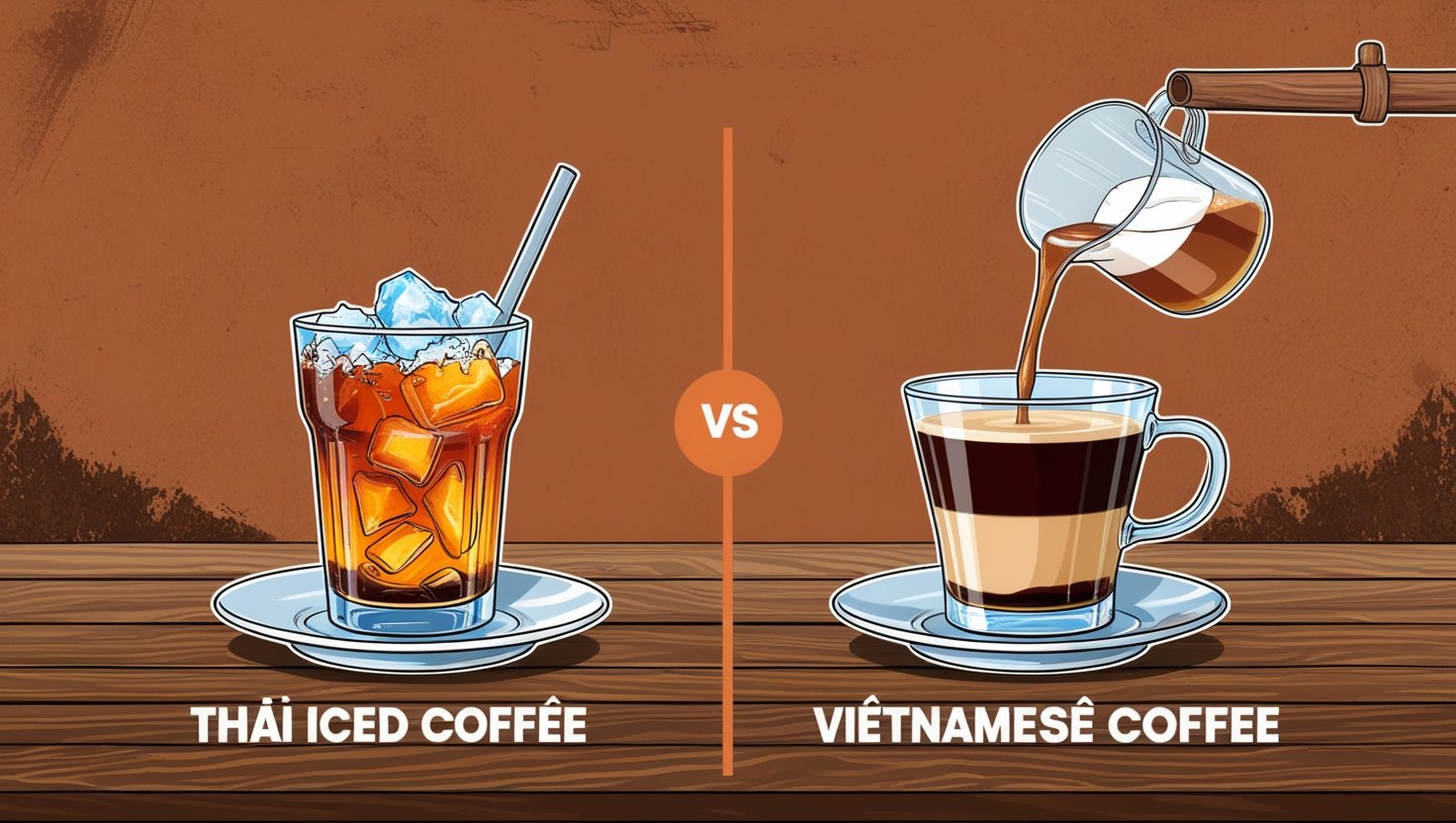
You sit down at a Southeast Asian café menu and see both Thai iced coffee and Vietnamese drip coffee staring back at you. One’s sweet and orange-tinted. The other, dark and rich with a layered look. Both are iced. Both are strong. But what actually makes them different?
In this article, we’ll compare Thai coffee vs Vietnamese coffee across ingredients, brewing methods, flavors, and cultural roots. Whether you’re a home brewer or café explorer, you’ll learn what sets these two iconic drinks apart—and which one fits your taste.
What Is Thai Coffee?
Thai coffee, known locally as oliang, is a traditional iced drink made with a blend of coffee and other roasted grains or seeds. It’s typically brewed using a sock filter and served over ice with sweetened condensed milk or evaporated milk.
Ingredients in Thai Coffee:
-
Coarsely ground coffee (often robusta)
-
Roasted corn, rice, sesame seeds, or tamarind seed (varies by vendor)
-
Sugar and condensed milk or evaporated milk
Flavor Profile:
-
Sweet, nutty, and aromatic
-
Lighter body compared to Vietnamese coffee
-
Often has a burnt caramel or smoky flavor
What Is Vietnamese Coffee?
Vietnamese coffee (cà phê sữa đá) is made with strong dark roast robusta coffee using a metal drip filter called a phin. It’s brewed directly into a glass containing sweetened condensed milk and poured over ice.
Ingredients in Vietnamese Coffee:
-
Dark roast robusta coffee
-
Sweetened condensed milk
-
Hot water
-
Ice (optional for iced version)
Flavor Profile:
-
Bold, intense, and deeply roasted
-
Very sweet and creamy
-
Syrupy texture
Brewing Methods: Traditional & Modern
| Feature | Thai Coffee | Vietnamese Coffee |
|---|---|---|
| Brewing Tool | Cloth sock filter (tungdtom) | Metal drip filter (phin) |
| Time to Brew | Fast (3–5 minutes) | Slow (5–7 minutes) |
| Serving Temperature | Usually iced | Hot or iced |
| Coffee Texture | Medium-bodied | Heavy and dense |
Both are brewed without espresso machines, making them accessible for home brewers with simple tools.
Caffeine and Strength
| Drink | Type of Coffee Used | Approx. Caffeine per 8 oz |
|---|---|---|
| Thai Coffee | Robusta blend | 80–120 mg |
| Vietnamese Coffee | Pure robusta | 100–150 mg |
Vietnamese coffee is typically stronger because of the high-caffeine robusta beans and slow extraction, but both offer a serious energy kick.
Cultural Roots & Traditions
Thai Coffee Origins:
-
Originates from street markets and roadside vendors.
-
The use of additional roasted grains makes it more economical and uniquely flavored.
-
Commonly served in plastic bags or metal cups with crushed ice.
Vietnamese Coffee Origins:
-
Introduced during French colonial rule in the 19th century.
-
Sweetened condensed milk became popular due to a lack of fresh milk.
-
Drip brewing is often a slow, intentional ritual—meant to be savored.
Both drinks reflect their country’s resourcefulness and culture of community-based coffee consumption.
Visual Differences
| Feature | Thai Coffee | Vietnamese Coffee |
|---|---|---|
| Color | Orange-brown or caramel | Dark brown with creamy base |
| Presentation | Tall glass, layered or mixed | Short glass with visible milk layer |
| Texture | Light and icy | Thick and syrupy |
Cost and Accessibility
| Aspect | Thai Coffee | Vietnamese Coffee |
|---|---|---|
| Cost per serving | Slightly cheaper | Slightly more expensive |
| Ingredient access | Harder outside Thailand | Easier to source globally |
| Brewing gear | Sock filter, easily DIY | Phin filter, widely sold |
Vietnamese coffee gear is easier to find online or in global grocery stores, while Thai-style sock filters might require more DIY improvisation or specialty shops.
Coffea Alchemy’s Take
At Coffea Alchemy, we love how Thai and Vietnamese coffees each offer a distinct lens into Southeast Asia’s coffee culture. For those who crave bold and creamy flavors, Vietnamese coffee delivers an unbeatable experience. Meanwhile, Thai coffee’s blend of roasted grains and cooling sweetness makes it perfect for adventurous palates. Either way, our ethically sourced robusta beans are an ideal base for both styles—giving home brewers the authenticity and flavor they’re after.
Tips for Making Each at Home
Thai Coffee Tips:
-
Use a blend that includes chicory or roasted grains for authenticity.
-
Brew strong and strain well to avoid sediment.
-
Add crushed ice—not cubes—for that street-style texture.
Vietnamese Coffee Tips:
-
Use a phin filter for traditional brewing.
-
Don’t rush the drip—it’s part of the experience.
-
Stir thoroughly before pouring over ice.
Recap: Thai Coffee vs Vietnamese Coffee
| Comparison Area | Thai Coffee | Vietnamese Coffee |
|---|---|---|
| Roast Type | Medium-dark + grains | Dark robusta |
| Flavor Profile | Nutty, sweet, herbal | Bold, sweet, creamy |
| Brew Method | Sock filter | Phin drip filter |
| Sweetener | Condensed or evaporated milk | Sweetened condensed milk |
| Typical Texture | Icy, light, fragrant | Thick, rich, dessert-like |
| Caffeine Level | Moderate | High |
| Best For | Refreshing afternoon drink | Dessert coffee or strong buzz |
Final Thoughts
Thai and Vietnamese coffees offer rich, unique experiences that go beyond your average cold brew or latte. Whether you’re into fragrant herbal blends or bold sweet espresso-like drinks, there’s something deeply satisfying in both cups.

